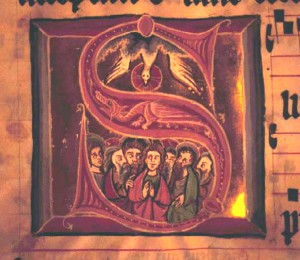
The Holy Spirit is an elusive enigma. The Holy Spirit – one of three different yet same incarnations of the one true God (dwell on that paradoxical nonsense for a moment) – is a central figure in the Christian Holy Trinity; it is an entity which all Christians are said to possess. Yet, it’s presence and physical properties conveniently and mysteriously escape the detection of modern scientific methods and instruments. It reminds me of the dragon story in Carl Sagan’s classic, The Demon-Haunted World – Science as a Candle in the Dark. To paraphrase the story:
Imagine I say to you that I have a real live dragon in my garage – surely you’d want to see it for yourself. What an opportunity, you think, to see a dragon, of which have been the stories of legends over the centuries, but has left no evidence.
“Show me,” you say, and I lead you to my garage. You look inside and see some bags of sand, cans of spray paint, some interesting goggles, and other items in my garage, but no dragon.
“Where’s the dragon?” you ask.
“Right here.” I reply, waving vaguely. “I neglected to mention the dragon is invisible.”
Hmm, you think. You propose spreading some sand on the floor of the garage to capture the dragon’s footprints.
“Good idea.” I say, “but this is also a floating dragon.”
Well then you’ll use those infrared sensor googles over there to detect the invisible fire.
“Good idea, but the invisible fire is also heatless.”
Ok, so you’ll spray paint the dragon to make it visible.
“Good idea, but it’s an incorporeal dragon and the paint won’t stick. And so on. And so on. And so on. I counter every physical test you propose with a special explanation of why it won’t work.
Now let me ask you this. What is the difference between an invisible, incorporeal, floating dragon who spits heatless fire and no dragon at all? If there’s no way to disprove my dragon proposition, no conceivable experiment that would count against it, what does it mean to say that my dragon exists?
Maybe, the only thing that you have really learned from my insistence that there’s a dragon in my garage is that there is something funny going on inside my head. Maybe you’d also wonder, if there are no physical tests that apply – nothing to show its mass, nothing to show its heat, nothing to show its chemistry – then what convinced me of the dragon’s existence in the first place?
The analogy between my dragon and the Holy Spirit should be clear at this point. If the Holy Spirit resides within us, then we should be able to test for it. We should, for example, be able to turn to the index of any biology textbook and reference the Holy Spirit just like we can for proteins, enzymes, neurotransmitters, DNA, ATP, lipids, the biochemistry of muscle fibers, the chemistry and structure of cells, the mechanisms of the nervous system, and on and on and on.
Until we can have any verifiable evidence of its existence it is safe to say that the Holy Spirit is imaginary.
Further reading: Science as a Candle in the Dark by Carl Sagan